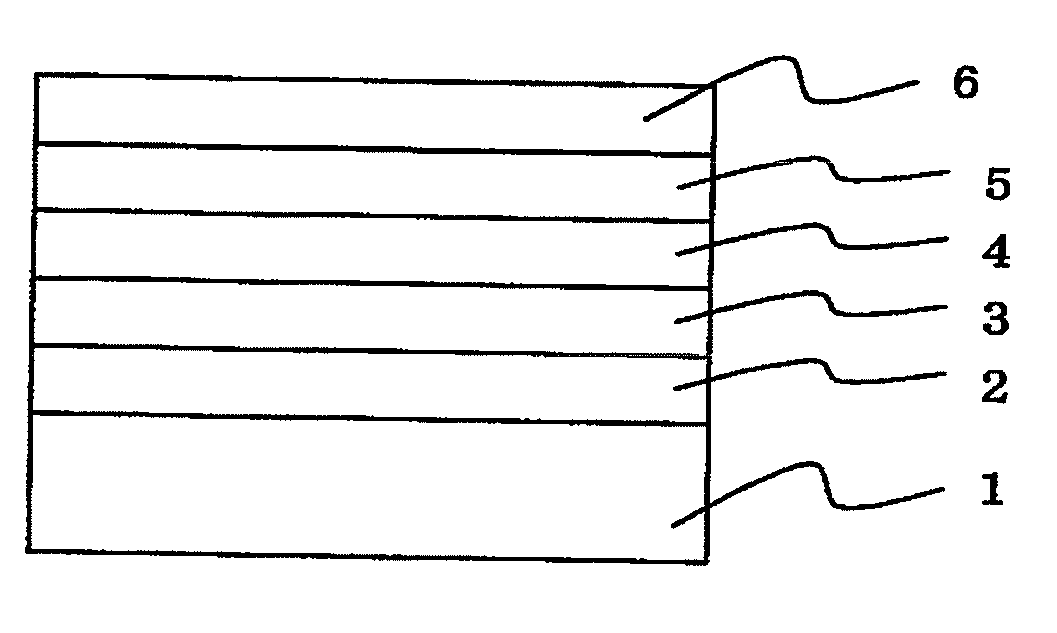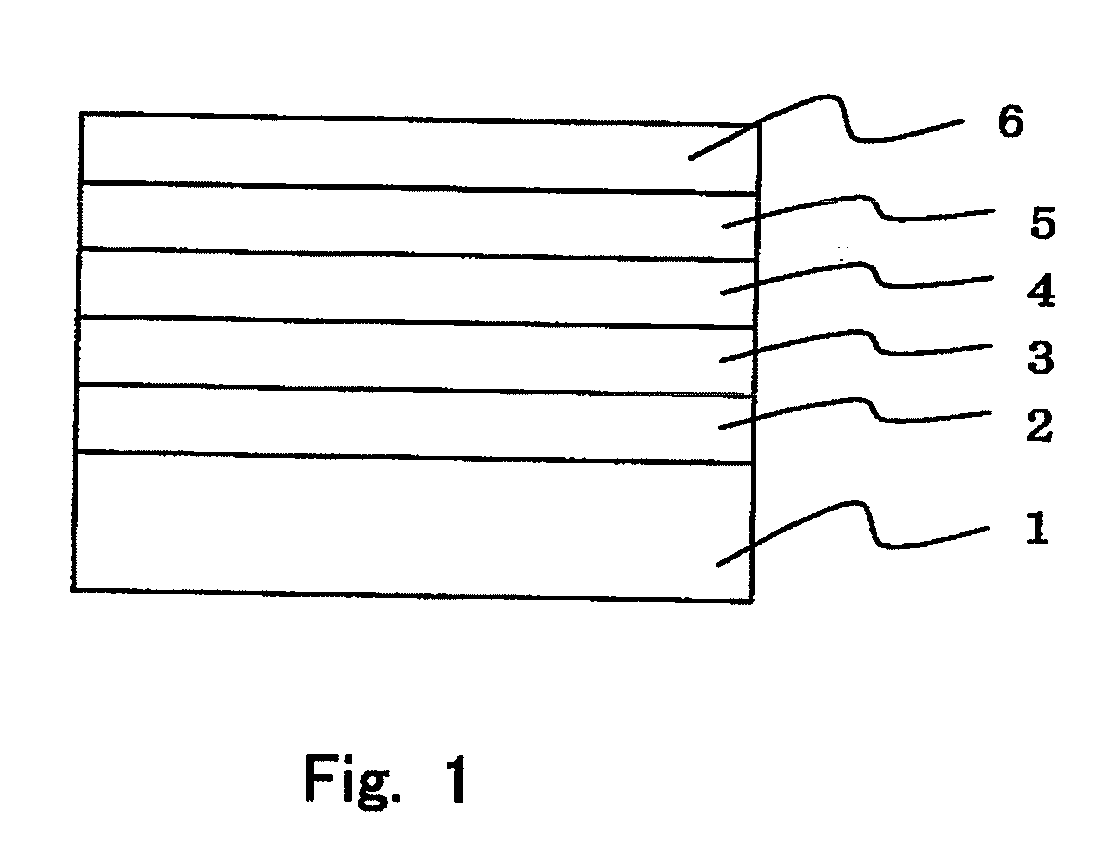Cyclic azine derivatives, processes for producing these, and organic electroluminescent element containing these as component
a technology of cyclic azine and derivatives, which is applied in the field ofcyclic azine compounds, can solve the problems of unsatisfactory basic materials of el devices, and achieve the effects of improving drivability, high efficiency, and enhancing light emission
- Summary
- Abstract
- Description
- Claims
- Application Information
AI Technical Summary
Benefits of technology
Problems solved by technology
Method used
Image
Examples
experiment example 1
[0240]
[0241]In a stream of argon, 1.50 g (3.98 mmol) of 2-(3,5-dichlorophenyl)-4,6-diphenylpyrimidine, 1.74 g (8.75 mmol) of 4-(2-pyridyl)phenylboronic acid, 2.85 g (8.75 mmol) of cesium carbonate, 36 mg (0.159 mmol) of palladium acetate and 152 mg (0.318 mmol) of 2-dicyclohexylphosphino-2′,4′,6′-triisopropylbiphenyl were suspended in 80 mL of 1,4-dioxane, and the obtained suspension was heated under reflux for 17 hours. The reaction mixture was cooled to room temperature, and was then distilled under a reduced pressure to remove all volatile materials. Methanol was added to the concentrate and the thus-deposited solid was collected by filtration. The thus-obtained crude product was purified by silica gel chromatography using chloroform as an eluent to give 2.19 g of the target 2-[4,4″-di(2-pyridyl)-1,1′:3′,1″-terphenyl-5′-yl]-4,6-diphenylpyrimidine as a white solid (yield: 90%).
[0242]1H-NMR (CDCl3): δ7.19-7.23 (m, 2H), 7.53-7.50 (m, 6H), 7.70-7.79 (m, 4H), 7.88 (d, J=8.5 Hz, 4H), 8...
experiment example 2
[0244]
[0245]In a stream of argon, 1.59 g (3.43 mmol) of 2-(3,5-dibromophenyl)-4,6-diphenylpyrimidine, 2.02 g (7.20 mmol) of 2-[3-(4,4,5,5-tetramethyl-1,3,2-dioxabororan-2-yl)phenyl]pyridine, 2.34 g (7.20 mmol) of cesium carbonate, 31 mg (0.1372 mmol) of palladium acetate and 131 mg (0.274 mmol) of 2-dicyclohexylphosphino-2′,4′,6′-triisopropylbiphenyl were suspended in 60 mL of tetrahydrofuran, and the obtained suspension was heated under reflux for 55 hours. The reaction mixture was cooled to room temperature, and was then distilled under a reduced pressure to remove all volatile materials. Methanol was added to the concentrate and the thus-deposited solid was collected by filtration. The thus-obtained crude product was purified by silica gel chromatography using a hexane / chloroform (1:1) mixed solvent as an eluent to give 1.69 g of the target 2-[3,3″-di(2-pyridyl)-1,1′:3′,1″-terphenyl-5′-yl]-4,6-diphenylpyrimidine as a white solid (yield: 80%).
[0246]1H-NMR (CDCl3): δ7.17-7.23 (m, 2...
experiment example 3
[0248]
[0249]In a stream of argon, 1.14 g (2.15 mmol) of 4,6-bis(2-biphenylyl)-2-(3,5-dichlorophenyl)pyrimidine, 0.90 g (4.52 mmol) of 4-(2-pyridyl)phenylboronic acid, 1.47 g (4.52 mmol) of cesium carbonate, 19 mg (0.086 mmol) of palladium acetate and 82 mg (0.172 mmol) of 2-dicyclohexylphosphino-2′,4′,6′-triisopropylbiphenyl were suspended in 40 mL of tetrahydrofuran, and the obtained suspension was heated under reflux for 18 hours. The reaction mixture was cooled to room temperature, and was then distilled under a reduced pressure to remove all volatile materials. The thus-deposited solid was collected by filtration. The thus-obtained crude product was purified by silica gel chromatography using a hexane / chloroform (1:1) mixed solvent as an eluent to give 0.60 g of the target 4,6-bis(2-biphenylyl)-2-[4,4″-di(2-pyridyl)-1,1′:3′,1″-terphenyl-5′-yl]pyrimidine as a white solid (yield: 37%).
[0250]1H-NMR (CDCl3): δ7.04 (s, 1H), 7.22-7.36 (m, 10H), 7.45-7.59 (m, 8H), 7.80-7.89 (m, 8H), 7....
PUM
| Property | Measurement | Unit |
|---|---|---|
| temperature | aaaaa | aaaaa |
| temperature | aaaaa | aaaaa |
| temperature | aaaaa | aaaaa |
Abstract
Description
Claims
Application Information
 Login to View More
Login to View More - R&D
- Intellectual Property
- Life Sciences
- Materials
- Tech Scout
- Unparalleled Data Quality
- Higher Quality Content
- 60% Fewer Hallucinations
Browse by: Latest US Patents, China's latest patents, Technical Efficacy Thesaurus, Application Domain, Technology Topic, Popular Technical Reports.
© 2025 PatSnap. All rights reserved.Legal|Privacy policy|Modern Slavery Act Transparency Statement|Sitemap|About US| Contact US: help@patsnap.com



